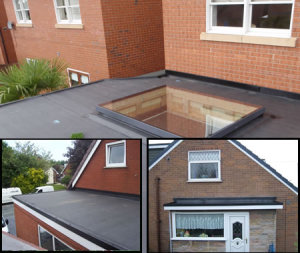Know the Different Types of Flat Roof Solutions
People who choose flat or low-sloped roofs for their houses do so because of functionality and aesthetics. A flat roof, like other roof types, has the main function of protecting the house against the elements. In addition, flat and other low-sloped roofs look great on a variety of architectural styles including modern buildings.
While old flat roofs do not last as long as their pitched counterparts, advances in technology over the past decades saw the development of new membranes that can compete with pitched roofs in terms of lifespan. For those interested in knowing the common membranes available in the different types of flat roof solutions, we listed them below.
TPO
Flexible Thermo Polyolefin (TPO) is designed to correct issues associated with other Thermoplastic membranes by possessing better seam, puncture and tear strength. Sales of TPO membrane roofing in the United States exceed all other types of flat roofs. TPO is considered a green product because it can be recycled 100% without chemical byproduct.
EPDM
EPDM (ethylene propylene diene monomer) is a synthetic rubber and the most widely-used single-ply roof membranes. It is reasonably-priced and has a warranted lifespan of up to 30 to 50 years when properly applied.
Metal Flat Roof
Metal is ideal for both flat and pitched roofs. Different metals such as steel, zinc, aluminum and copper are used as covers. Although it costs more than other roofing materials, metal more than makes up for the upfront cost by its durability and low-maintenance.
Modified Bitumen
Modifiers such as APP (tactic polypropylene) and SBS (styrene-butadiene-styrene) are added to enhance the performance of traditional roofing asphalt. APP was added to asphalt bitumen to improve its ageing quality. SBS, on the other hand, improves substandard asphalt and make it flexible like rubber.
Asphalt
Asphalt built-up roof (BUR) membrane uses multiple plies of asphalt-impregnated felt embedded in bitumen. The asphalt is applied on the bitumen while still hot to merge and form a single-piece material. The membrane is laminated several layers (up to four plies) to form a thick material. It is protected from wear and tear and sunlight by embedding crushed stone and other granules on the surface. Unlike other roofing systems, asphalt roof installation is energy-intensive and adds to air pollution.
Turbo Seals
A gel-life membrane composed of 45% recycled tire rubber. It is placed on top of existing asphalt roofs and covered by a sheet membrane.
PVC Roofing
Polyvinyl Chloride (PVC) membrane roofing is also known as vinyl roofing. Because of its light color that reflects sunlight, PVC roofs are energy efficient. They are also used to waterproof green roofs.
